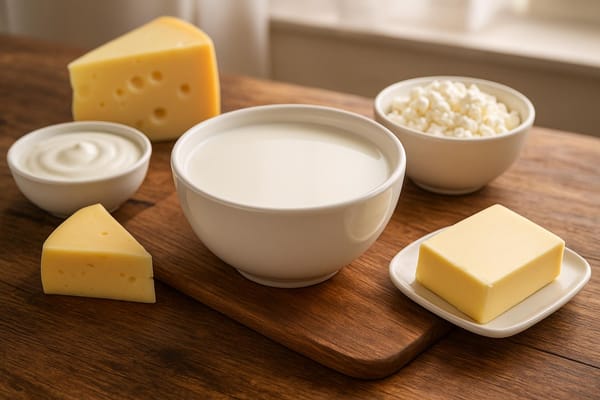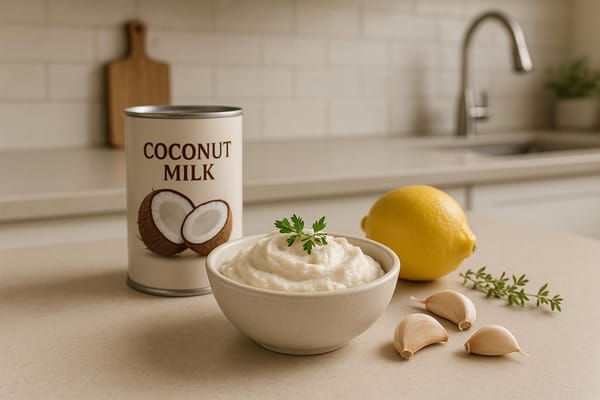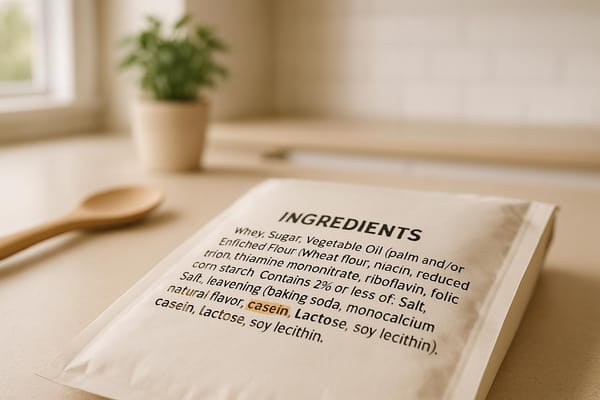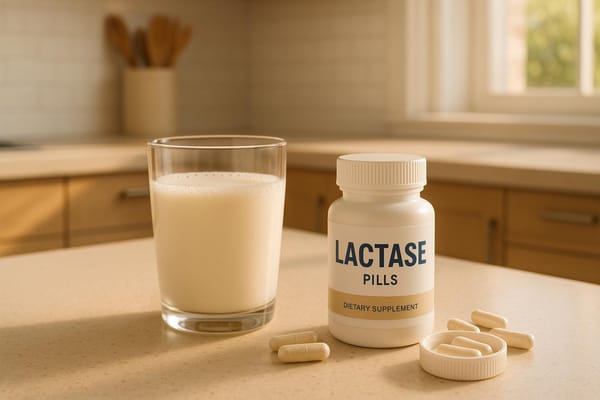Checklist for Balanced Dairy-Free Meal Planning
Learn how to effectively plan balanced, nutritious meals while following a dairy-free diet, ensuring you meet your essential nutrient needs.
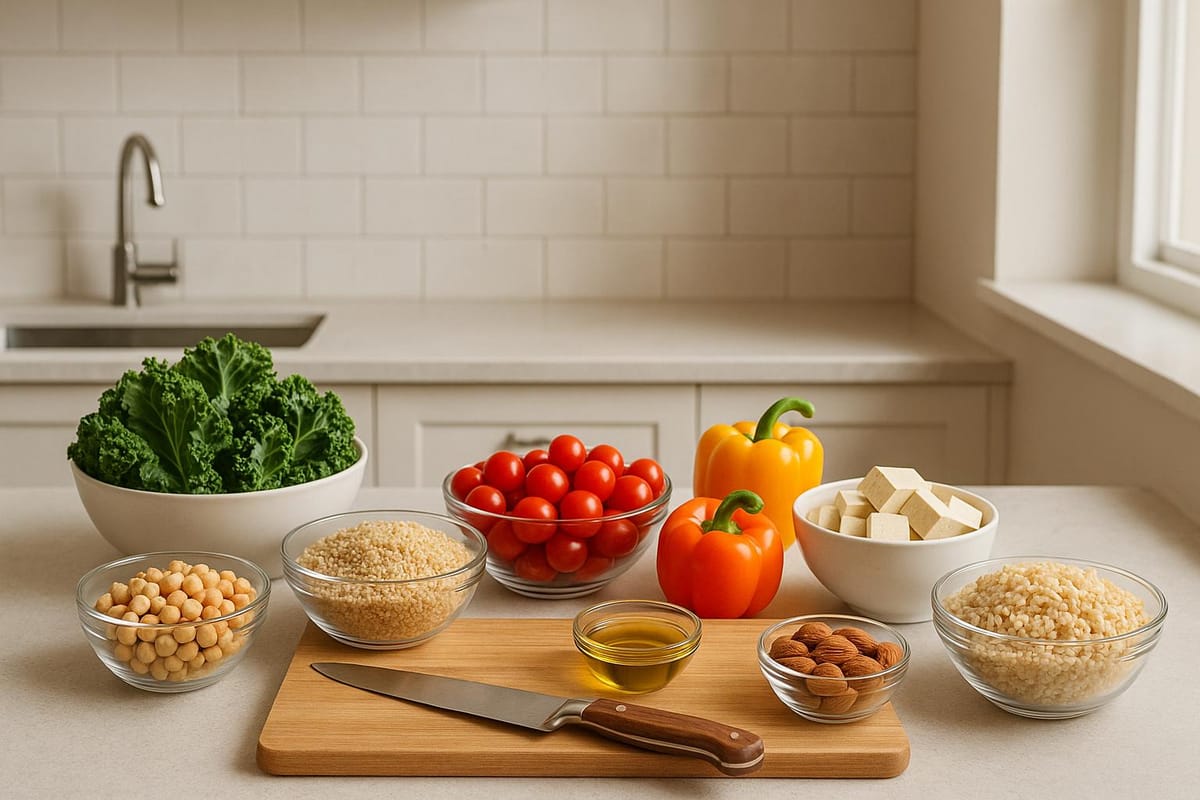
Switching to a dairy-free diet can feel overwhelming, but with the right plan, you can meet your nutritional needs without dairy. Here's the key takeaway: focus on replacing dairy's nutrients - like calcium, protein, vitamin D, and B12 - with alternatives from plant-based and fortified foods. This ensures your meals stay nutritious, balanced, and satisfying.
Quick Tips for Balanced Dairy-Free Meals:
- Protein Sources: Incorporate soy products (tofu, tempeh), legumes (peas, beans), nuts, seeds, and whole grains like quinoa.
- Healthy Fats: Use avocados, olive oil, and nuts for energy and nutrient absorption.
- Calcium & Vitamin D: Choose fortified plant-based milks, leafy greens, and calcium-rich options like tahini or fortified cereals.
- Omega-3s: Add chia seeds, flaxseeds, walnuts, or algae-based supplements to your diet.
- Vitamin B12: Rely on fortified foods (cereals, nutritional yeast) or supplements to avoid deficiencies.
Planning is key. Batch-cook grains, veggies, and proteins to simplify meal prep, and use a checklist to track nutrient intake. For occasional dairy indulgences, products like milktab can ease digestion.
$25 for 7 Days | High Protein, Dairy Free, Low Sugar, and Naturally GF | Single Person Meal Plan
Key Macronutrients and Their Dairy-Free Sources
Switching to a dairy-free diet means finding alternative sources for carbohydrates, proteins, and fats. Protein, which should make up about 25% of your daily calories, requires special attention to ensure you're meeting your nutritional needs.
Let’s dive into some excellent dairy-free options for these essential macronutrients.
Carbohydrates
Carbohydrates are your body’s main energy source, and there are plenty of dairy-free options to keep you fueled. Whole grains, fruits, vegetables, and legumes are fantastic choices, as they provide complex carbs, fiber, and protein.
Take quinoa, for example. Not only is it a great carb source, but it also packs 8.4 grams of protein per cooked cup. Another standout is sorghum, with an impressive 20.4 grams of protein per uncooked cup.
Legumes are another nutrient-dense option. Green peas deliver 8 grams of protein per cup, rivaling the protein content of cow’s milk, while also offering fiber and vitamins. Red kidney beans and black-eyed peas are equally impressive, providing about 14 grams and 12 grams of protein per cup, respectively.
Incorporating a variety of these carbohydrate sources helps you avoid common nutrient gaps that can occur on a dairy-free diet. Now, let’s look at protein-rich foods to round out your meals.
Proteins
Getting enough protein without dairy might seem challenging, but it’s entirely doable with some planning. Soy products like soy milk, tofu, and tempeh are excellent high-protein options. Soybeans, in particular, stand out for their superior protein content, making them a cornerstone of plant-based diets.
Nuts and seeds are another fantastic source of protein. Most nuts provide around 5–6 grams of protein per ounce. Here’s a quick breakdown of some protein-packed options:
| Protein Source | Protein Content |
|---|---|
| Hemp seeds | Nearly 10g per ounce |
| Pumpkin seeds | Nearly 10g per ounce |
| Kidney beans | 26g per 2 cups |
| Red kidney beans | 14g per cup |
| Green peas | 8g per cup |
| Quinoa (cooked) | 8.4g per cup |
| Black-eyed peas | 12g per cup |
For something a little different, try nutritional yeast, which offers 8 grams of protein and 3 grams of fiber in just half an ounce. Or consider Ezekiel bread - two slices provide about 8 grams of protein, making it a great choice for sandwiches or toast.
Fats
Healthy fats are essential for energy and overall health, and dairy-free diets offer plenty of options. Plant-based oils like olive oil, avocado oil, ground flaxseed oil, and canola oil are excellent choices. They’re perfect for cooking, salad dressings, or simply drizzling over dishes for added richness.
Nuts and seeds are also rich in healthy fats, with each type offering a unique nutritional profile. Whether you prefer almonds, walnuts, or sunflower seeds, these are great for snacking or adding to meals.
And let’s not forget avocados - a standout fat source that also delivers fiber, potassium, and vitamins. Their versatility is unmatched; use them in smoothies, spread them on toast, or blend them into creamy dressings.
The Power of Variety
The secret to a balanced dairy-free diet is variety. By mixing and matching plant-based protein sources throughout the day, you can ensure you’re getting a complete amino acid profile. This approach not only keeps your meals flavorful but also guarantees you’re meeting your nutritional needs without missing a beat.
Common Nutrient Gaps in Dairy-Free Diets
Cutting dairy out of your diet means losing a key source of several important nutrients. In the U.S., dairy products provide 72% of calcium, 20% of vitamin B12, 16% of vitamin A, and significant amounts of riboflavin, potassium, zinc, magnesium, and high-quality protein. Without careful planning, this can leave noticeable nutritional gaps.
"If you remove a major source of nutrients from your diet (in this case, dairy) you must ensure you are obtaining them from alternative sources." - Michelle Kickham, Scientist
These gaps can lead to issues like brittle bones, weakened muscles, and even disrupted metabolism. The most commonly affected nutrients are calcium, vitamin D, vitamin B12, and omega-3 fatty acids.
Calcium and Vitamin D
Calcium is often the first concern when someone goes dairy-free - and for good reason. Adults aged 19–50 need about 1,000 mg of calcium per day, which is roughly three 8-ounce servings of dairy. However, those who are lactose intolerant or avoid dairy often fall short, consuming just 388 to 739 mg daily - far below the recommended amount.
The consequences are clear: vegans, for example, face a 30% higher risk of bone fractures compared to omnivores and vegetarians, largely due to insufficient calcium intake. But don’t worry - there are plenty of dairy-free ways to meet your calcium needs.
Some of the best options include:
- Fortified plant-based milks (soy, oat, almond, rice, hemp, etc.). Be sure to check labels, as "organic" varieties often lack added calcium.
- Leafy greens like kale, spinach, cabbage, and watercress.
- Tinned fish with bones, such as sardines or salmon.
- Nuts and seeds, particularly sesame seeds and tahini.
- Dried fruits, including figs and apricots.
- Fortified cereals and breads made with enriched flour.
Vitamin D is another critical nutrient for bone health, as it helps your body absorb calcium. While sunlight is the primary source, many people need supplements during the darker months (October through March).
Vitamin B12
Vitamin B12 is another nutrient that’s easy to miss in a dairy-free diet. Adults require about 2.4 micrograms daily. Since milk and dairy are excellent sources of bioavailable B12, those avoiding them need to find alternatives.
Some effective dairy-free sources of B12 include:
- Fortified breakfast cereals (check the label for B12 content).
- Fortified nutritional yeast, which can also add a cheesy flavor to meals.
- B12 supplements, available in swallowable, chewable, or sublingual forms.
Research from 2004 shows that consuming 1 cup of fortified cereal daily can significantly boost B12 levels. Similarly, a 2000 study found that adding nutritional yeast to vegan diets improved B12 levels and reduced deficiency markers. For those at greater risk of deficiency, supplements are often the most reliable solution.
Omega-3 Fatty Acids
Dairy-free diets can also impact your omega-3 intake, which is essential for heart and brain health. Most Americans consume omega-6 to omega-3 fatty acids at a ratio of 20:1, while the ideal balance is closer to 4:1.
"Omega-3 fatty acids are important for maintaining heart and brain health. But you don't need to turn to fish - or fish oil supplements - to get your omega-3s." - Physicians Committee for Responsible Medicine
Plant-based omega-3 sources provide alpha-linolenic acid (ALA), which your body can convert to EPA and DHA. Here are some excellent options:
| Food Source | Omega-3s per serving |
|---|---|
| Chia seeds (1 ounce) | 5.0g |
| Flaxseed (1 tbsp) | 2.4g |
| Walnuts (1 ounce) | 2.6g |
If you’re looking for direct sources of EPA and DHA - the same types found in fish - algae-based supplements are a great choice. These are especially beneficial for pregnant or lactating women, older adults, and those with chronic conditions.
Interestingly, research from the EPIC Study revealed that women following vegan diets had higher levels of long-chain omega-3 fats in their blood compared to meat eaters, fish eaters, and ovo-lacto vegetarians.
A quick note on iodine: Most non-dairy milks (like soy, almond, and oat) provide only 2 micrograms of iodine per serving, far below the recommended daily intake of 150 micrograms. Since iodine is critical for fetal brain development and preventing cognitive issues in children, consider including iodine-rich foods like eggs, seafood (especially cod), or supplements in your diet.
"Iodine matters because deficiency during pregnancy affects fetal brain development and is linked to lower intelligence in children." - Dr. Sarah Bath, University of Surrey
Sample Dairy-Free Meal Components and Substitutions
Crafting dairy-free meals that are both delicious and nutritionally balanced is easier than you might think. By focusing on key macronutrients - protein, healthy fats, and complex carbohydrates - you can create meals that satisfy and nourish. Here are some practical ideas and swaps to get you started.
Breakfast Ideas
A well-rounded, dairy-free breakfast can set the tone for the rest of your day. The trick is to combine protein, healthy fats, and complex carbs in a way that keeps you energized and full until lunch.
For quick and easy mornings, smoothies and breakfast bowls are a lifesaver. A tofu-soymilk smoothie or a bowl of oats with soy yogurt, nuts, seeds, and berries can replace the calcium and protein usually found in dairy. These options are not just convenient but also packed with flavor and nutrients.
If you prefer a hot breakfast, try dairy-free pancakes or waffles made with plant-based milk. Top them with fresh fruit and a dollop of dairy-free yogurt for an extra boost. For savory options, consider sweet potato hash or veggie-stuffed omelets made with chickpea flour or egg alternatives.
"When layered with a variety of ingredients, heart-healthy fats and proteins, breakfast salads are the perfect way to start the day."
– Maya Feller, M.S., RD, CDN
For those on the go, portable options like EatingWell's Vegan Freezer Breakfast Burritos - filled with tofu, beans, veggies, and salsa - are a great choice. Another quick idea is West Coast Avocado Toast: sprouted whole-wheat bread topped with hummus, sprouts, and avocado. Even a simple peanut butter and banana toast offers a satisfying mix of protein, fats, and carbs.
Lunch and Dinner Ideas
For lunch and dinner, focus on building balanced plates that include grains, vegetables, and protein. Grain bowls are a versatile option - combine quinoa, roasted veggies, leafy greens, and beans, then drizzle with tahini dressing for a meal rich in fiber, protein, and healthy fats. The tahini and greens also provide a calcium boost.
You can also recreate classic dishes with dairy-free twists. A broccoli "cheddar" soup made with nutritional yeast and dairy-free cheese delivers familiar flavors while sneaking in extra veggies. Coconut milk is a fantastic substitute for cream in curries, soups, and stews, adding a creamy texture with a hint of coconut. For pasta dishes, blended cashews or pureed white beans create a rich, creamy sauce.
Salads can be hearty and filling when you add protein. Toss in ingredients like canned salmon or sardines (with bones) for calcium and omega-3s, or blend avocado into your dressing for creaminess and healthy fats.
Dairy-Free Swaps
Knowing the right substitutes makes dairy-free cooking much simpler. Here are some reliable swaps for common dairy ingredients:
| Dairy Product | Best Dairy-Free Substitute | Notes |
|---|---|---|
| Milk (1 cup) | Plant-based milk (1 cup) | Soy milk works well in hearty dishes; oat milk has a mild flavor |
| Heavy cream | Full-fat coconut milk | Adds creaminess but may have a slight coconut taste |
| Butter | Dairy-free margarine | Opt for margarine with low water content for baking |
| Sour cream | Cashew cream or coconut-based alternatives | Blend cashews for a homemade option |
| Cheese | Nutritional yeast or modern plant-based cheeses | Newer dairy-free cheeses melt better |
| Buttermilk | 1 tbsp vinegar + 1 cup plant milk | Let sit for 5 minutes before using |
Experiment with these swaps to find what works best for your recipes and preferences. With the right ingredients, you can enjoy your favorite dishes without compromising on flavor or nutrition.
Practical Meal Planning Strategies
Once you've figured out dairy-free substitutes and meal ideas, the next step is setting up a system to make balanced eating feel easy. A little planning can turn what seems overwhelming into a simple, repeatable routine. This approach not only helps you maintain a good balance of macronutrients but also addresses common nutrient gaps in dairy-free diets. The key is starting with well-balanced plates as the foundation of your meal planning.
Building Balanced Plates
A good rule of thumb for a balanced plate is this: fill half with vegetables, one quarter with lean protein, and one quarter with whole grains. Add small amounts of healthy fats - like avocado, olive oil, or nuts - to boost nutrient absorption and keep you feeling full.
The beauty of this method is that it works with almost any dish. Whether you're making a grain bowl, stir-fry, or soup, these proportions can guide you. Once you’ve got the plate structure down, you can make things even easier by incorporating batch cooking into your routine.
Batch Cooking and Prepping
Batch cooking is a lifesaver when it comes to staying on track during a busy week. By preparing staple ingredients in advance - like grains, proteins, and vegetables - you can simplify daily meal prep.
Here’s how to get started:
- Cook a large batch of grains such as quinoa, brown rice, or farro.
- Roast a mix of vegetables like sweet potatoes, carrots, and broccoli all at once.
- Prepare proteins, whether it’s baked tofu, chicken breasts, or a big pot of beans.
Store everything in clear containers in your fridge. With these ready-to-go ingredients, assembling meals becomes as easy as mixing and matching. Having prepped components on hand removes the stress of deciding what to eat, especially on those hectic weekdays.
Using Checklists for Meal Tracking
A simple checklist can help you stay on top of your nutritional needs without overcomplicating things. Pay special attention to nutrients like calcium, vitamin D, and protein, which are crucial when cutting out dairy.
Your checklist can include daily goals like:
- Did I include a source of protein, healthy fats, and complex carbs in each meal?
- Did I eat calcium-rich foods three times today?
- Are omega-3s part of my meal plan?
- Have I included a variety of colorful vegetables?
By ticking off these boxes, you can ensure you’re meeting your nutritional goals without overthinking every detail. Plus, it reduces decision fatigue, making it easier to stick with your plan.
Whether you prefer a detailed weekly meal plan or a more flexible system with prepped ingredients, the key is finding what works best for your schedule and sticking to it.
Optional: Digestive Support for Lactose Intolerance
Even with a carefully planned dairy-free diet, life happens - sometimes you just want to indulge in a creamy dessert or a cheesy dish. For those moments, having reliable digestive support can make all the difference. Whether it’s a special occasion, a dinner out, or simply giving in to a craving for your favorite ice cream, targeted digestive help ensures you can enjoy these treats without regret.
milktab offers a triple-enzyme formula designed specifically for efficient dairy digestion. Each dose includes 27,000 FCC units of lactase, 22,000 FCC units of protease, and 1,000 FCC units of lipase. These enzymes work together to break down lactose, casein, and milk fats. Lactase converts lactose into simpler, more easily absorbed sugars, while protease and lipase handle proteins like casein and fats, respectively.
Compact and portable, milktab is perfect for on-the-go use.
"Milktabs WORK!! I went on a European vacation and ate all the cheeses I wanted - zero issues the whole trip." - Juana
For the best results, take milktab with your first bite or sip of dairy. If you’re consuming dairy over an extended period (like during a long meal), consider taking another dose after 30–45 minutes to keep the enzymes active.
An observational study involving 64 participants highlighted its effectiveness, showing a 58% reduction in abdominal pain and nausea, 75% less bloating, and 67% fewer instances of diarrhea.
This product is vegan, non-GMO, and FODMAP-free, making it a great option for those with specific dietary restrictions. It’s also third-party tested for quality and safe for children aged 4 and up.
With milktab as a backup, you can enjoy occasional dairy indulgences without worrying about digestive discomfort. It offers flexibility and peace of mind, complementing your dairy-free lifestyle while helping you stick to your nutritional goals.
Conclusion: Simplify Dairy-Free Meal Planning
Planning a balanced dairy-free diet doesn’t have to be complicated. The trick is to focus on what you can enjoy instead of fixating on what’s off-limits. Shifting your mindset opens up a world of dairy-free foods and recipes, turning meal planning into an opportunity to discover new flavors and ingredients. This builds on the strategies we’ve already discussed.
Finding the right substitutes can make the transition smoother. Try options like coconut milk for creamy sauces, cashew cream for desserts, almond milk for coffee, or plant-based yogurts for breakfast. Once you identify alternatives that work for your taste and routine, incorporating them into your meals becomes second nature.
It’s also important to include healthy fats in your meals. Foods like avocados, nuts, olive oil, and coconut milk not only add flavor but also provide essential nutrients. These fats help with nutrient absorption and keep you feeling fuller longer, making them a key part of a balanced dairy-free diet.
Stay alert for hidden dairy ingredients, especially when reading labels or dining out. Ingredients like whey, casein, and lactose can show up in unexpected places, so being mindful ensures you stick to your goals and avoid setbacks.
Using a checklist approach to meal planning can help you stay organized while keeping your diet varied and enjoyable. By covering all the essentials - macronutrients, potential deficiencies, and meal components - you create a sustainable and satisfying plan. This method, as outlined earlier, simplifies the process and keeps you on track.
For those occasional moments when you need a little extra flexibility, tools like milktab can provide a helpful backup. Combining thoughtful planning with practical solutions ensures you can maintain a dairy-free lifestyle that fits your needs and preferences.
FAQs
How can I make sure I get enough calcium and vitamin D on a dairy-free diet?
To keep your calcium and vitamin D levels balanced while avoiding dairy, focus on incorporating calcium-packed foods into your meals. Great options include canned salmon or sardines (with their bones), collard greens, broccoli, fortified plant-based milks, and cereals with added calcium.
For vitamin D, turn to fatty fish like salmon and tuna, or opt for fortified foods such as plant-based milks and cereals.
If you find it tough to get enough from food alone, supplements can help bridge the gap. Be sure to read product labels to confirm they include added calcium and vitamin D. For tailored advice, it's always a good idea to consult with a healthcare provider or dietitian to ensure your diet meets your specific needs.
How can I include a variety of plant-based proteins to ensure my meals provide all essential amino acids?
To make sure your meals include all the essential amino acids, try combining various plant-based protein sources. A simple approach is pairing grains - like rice, oats, or whole wheat - with legumes such as beans, lentils, or chickpeas. Popular combos like rice and beans or hummus with whole wheat bread are both tasty and effective.
You can also add naturally complete plant proteins to your diet. Options like quinoa, soy, or amaranth already pack all nine essential amino acids, making them a fantastic choice for variety and nutrition. By mixing these ingredients, you can whip up well-rounded, dairy-free meals that support your dietary needs.
What are the best tips for planning balanced dairy-free meals?
To create well-rounded dairy-free meals, make sure to incorporate calcium-rich alternatives like leafy greens, fortified plant-based milks, and canned fish with bones. Include healthy fats such as avocados, nuts, and seeds to round out your nutritional needs.
Preparing meals ahead of time - think soups, salads, or grain bowls - can save both time and effort while keeping your diet varied. Planning your meals for the week and making a detailed grocery list ensures you get all the essential nutrients and helps you avoid impulsive, less healthy choices. Staying organized and focusing on nutrient-packed ingredients makes sticking to a dairy-free diet manageable and satisfying.
